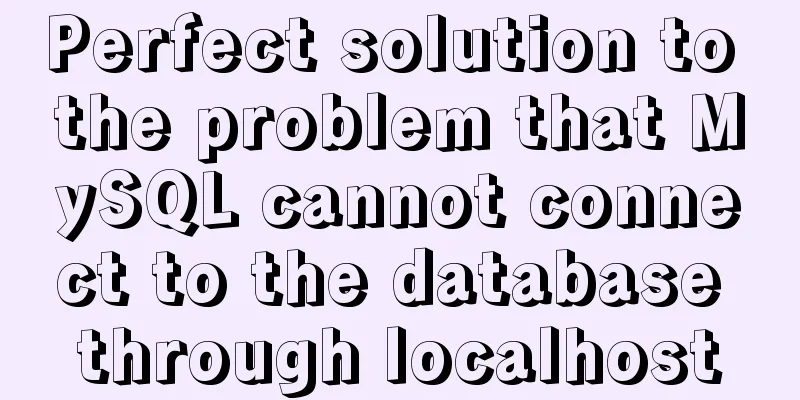Detailed explanation of how to solve the conflict of project URLs caused by setting the default path of Tomcat

|
Preface Tomcat is an excellent Java container, but there are still some small pitfalls that cannot be avoided. I will record them here. START question
Scenario Description 1. There are two projects under webapps, projectA and projectB. Except for the management information interface, the other two projects have security verification mechanisms. 2. Since projectA is not separated from the front-end and back-end, the static resources also exist in the Java project. When making interface requests in static resources, the package name is not written. For example, when logging in, the js code will concatenate the server ip+port+currently set url (/login), but not add /projectA before /login. Therefore, there is no problem in testing on the local machine, and such a problem will only occur when deploying. This is also a problem, which will be solved below. 3.projectB is a normal running project Solution for scenario 2 Open the configuration file in tomcat, add <Context> in the <Host> tag to set it as the default access path of the server, so as to avoid the package name, but this method is extremely informal and is not recommended.
<Host name="localhost" appBase="webapps"
unpackWARs="true" autoDeploy="true">
<!-- SingleSignOn valve, share authentication between web applications
Documentation at: /docs/config/valve.html -->
<!--
<Valve className="org.apache.catalina.authenticator.SingleSignOn" />
-->
<!-- Access log processes all example.
Documentation at: /docs/config/valve.html
Note: The pattern used is equivalent to using pattern="common" -->
<Valve className="org.apache.catalina.valves.AccessLogValve" directory="logs"
prefix="localhost_access_log" suffix=".txt"
pattern="%h %l %u %t "%r" %s %b" />
<Context path="" docBase="/usr/tomcat8.6/webapps/sc_edu" debug="0" reloadable="true"/>
</Host>
Code Explanation <Context path="" docBase="/usr/tomcat8.6/webapps/sc_edu" debug="0" reloadable="true"/>
Then our solution is to install another tomcat and only deploy projects that require direct path mapping This will return to the directory where tomcat is located, and the cp command will copy $> cp -r tomcat8.5/ tomcat8.6/ Then move projectA in tomcat8.5 to tomcat8.6. Delete the tomcat8.5 <Context path="" docBase="/usr/tomcat8.6/webapps/sc_edu" debug="0" reloadable="true"/> In tomcat8.6, the following changes need to be made to service.xml. Change the port corresponding to shutdown to 8006, as long as it is different from tomcat8.5 and the port does not conflict. <Server port="8006" shutdown="SHUTDOWN"> Change the port corresponding to the request, the principle is the same as above
<Connector port="8081" protocol="HTTP/1.1"
connectionTimeout="20000"
redirectPort="8443" />
The content in the <Host> tag is copied and needs to be modified to the corresponding mapping path. In this way, two tomcats can run at the same time, and startup and shutdown do not affect each other. The above is the full content of this article. I hope it will be helpful for everyone’s study. I also hope that everyone will support 123WORDPRESS.COM. You may also be interested in:
|
<<: MySQL 5.7.18 download and installation process detailed instructions
Recommend
Several ways to hide Html elements
1. Use CSS Copy code The code is as follows: style...
Understanding render in Vue scaffolding
In the vue scaffolding, we can see that in the ne...
10 Popular Windows Apps That Are Also Available on Linux
According to data analysis company Net Market Sha...
Problems with Vue imitating Bibibili's homepage
Engineering Structure The project is divided into...
Introduction to the difference between on and where conditions in MySQL left join operation
Priority The reason why placing the same conditio...
Mysql Sql statement comments
You can add comments to MySQL SQL statements. Her...
HTML table tag tutorial (13): internal border style attributes RULES
RULES can be used to control the style of the int...
Summary of Docker Consul container service updates and issues found
Table of contents 1. Container service update and...
Detailed explanation of NodeJS modularity
Table of contents 1. Introduction 2. Main text 2....
HTML Basics - Simple Example of Setting Hyperlink Style
*** Example of setting the style of a hyperlink a...
The problem of jquery.form.js denying access in IE and the input upload button must be actively clicked
Let's take a look at the code first <form ...
Vue local component data sharing Vue.observable() usage
As components become more detailed, you will enco...
Several ways to connect tables in MySQL
The connection method in MySQL table is actually ...
mysql implements importing only a specified table from the sql file of exported data
Scenario Yesterday the system automatically backe...
Detailed tutorial on installing Nginx 1.16.0 under Linux
Because I have been tinkering with Linux recently...









